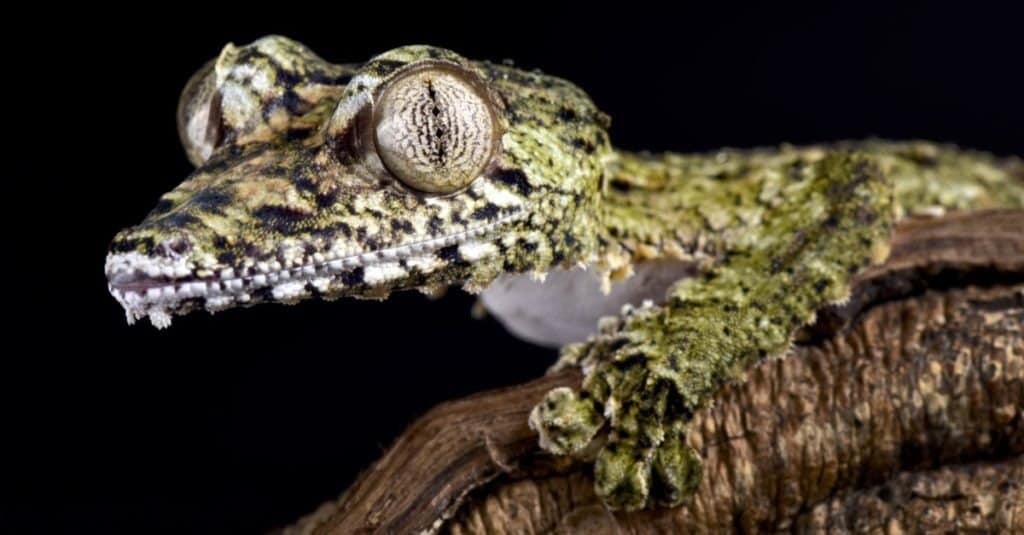Geckos are a pretty unusual bunch of reptiles, with perhaps their most bizarre and noteworthy trait being their massive, bulging eyes. If you own one of these unique lizards or have ever spent any time up-close and personal with them, you may have initially been taken aback upon seeing them lick their own eyes!
While this behavior looks strange and even silly, it serves a few important biological purposes. Let’s take a closer look at why geckos lick their eyes so much below.
Why Do Geckos Lick Their Eyes?

Geckos lick their eyes to moisten and clean them.
©reptiles4all/Shutterstock.com
The majority of gecko species lack any kind of movable eyelids altogether. As a result, they are unable to blink or close their eyes to protect them. Fortunately, geckos have long, flexible tongues, so they simply lick their eyes periodically. This keeps their eyes moist and prevents dirt, sand, and other debris from entering them.
The main reason why many geckos’ eyes look so massive is most species don’t have eyelids to partially cover them! Instead, they only have corneas, which are essentially very thin, transparent membranes covering the surface of each eye.
These invisible corneas help somewhat to protect their sensitive pupils and sclera. However, geckos also need to do a bit of work themselves to keep their eyes moist and clean. Normally, they would occasionally blink to moisten and protect their eyes, but without eyelids, this is impossible. This is where their long, sticky, flexible tongues come in, which they use to lick the surface of their eyeballs.
By licking their eyes every so often, geckos can keep their eyes nice and moist and free of pesky, irritating debris, which would normally obstruct their vision and potentially cause painful, debilitating eye infections.
Do Any Geckos Have Eyelids?

Leopard
geckos are one of the few gecko species with movable eyelids.
©iStock.com/Nynke van Holten
Interestingly, a handful of gecko species–currently 43 of them, to be exact–actually have fully functioning, movable eyelids! This family, known taxonomically as Eublepharidae, makes up a very small percentage of the more than 1,500 total types of geckos. The name Eublepharidae is, of course, Latin, and it loosely translates to “good/true eyelids.”
Most Eublepharid lizards live in very dry, sandy environments throughout Asia and Africa’s deserts and steppes. Evolving to have eyelids has greatly helped these lizards survive their unforgiving habitats. These unique geckos occasionally still lick their eyes to keep dirt out of them, though.
Notably, this family includes the popular leopard gecko and African fat-tailed gecko. Both of these species are very popular in the pet trade.
Why Do Geckos Have Such Large Eyes?

This Satanic leaf-tailed gecko’s huge, bulging eyes give it incredible eyesight, even in nearly pitch-black darkness.
©iStock.com/reptiles4all
Most gecko species are nocturnal, so they mostly sleep during the day and hunt and socialize at night. They’ve evolved to have excellent eyesight, particularly night vision. This is in part aided by their very large eyes and pupils, which can contract and expand greatly to control how much light they take in. Their already massive eyes look even larger, thanks to the fact that most species lack eyelids.
By expanding their pupils at night, geckos can take in every last bit of light to utilize it and navigate their dim, often densely forested environments. Their keen night vision lets them evade many of their natural predators that would normally hunt them during the day while they search for and gobble up small insects and arachnids with ease.
Even in very low-light conditions, the average gecko’s eyesight is several hundred times more sensitive than that of a human! Geckos have three types of cone cells that allow them to see colors well into the ultraviolet range of the spectrum.
What’s more, geckos have a uniquely multifocal vision. This allows them to focus on multiple objects at different distances simultaneously! Even though their bulging eyes look a bit eerie, they are structured in a way that gives them exceptional eyesight–and an excellent range of vision, too.
Do Geckos Sleep With Their Eyes Open?

Geckos will “close” their eyes by tightly constricting their thin, vertical pupils.
©Sefa Kaya/Shutterstock.com
Because most geckos lack eyelids, it seems like a mystery how they’d be able to sleep, if at all. However, all animals need to sleep at some point, including these funky little lizards! While Eublepharid geckos can fully close their eyelids to sleep, this only accounts for around 40 of the world’s over 1,500 gecko species.
When they feel the need to sleep, most geckos will simply constrict their pupils very tightly. By doing this, their eyes can absorb as little light as possible. This is their way of “closing” their eyes without eyelids.
If you own a pet gecko lacking eyelids, such as the popular crested gecko, you can tell when they’re sleeping just by looking at the size of their pupils! If their pupils look like thin, barely-visible slits, your gecko is probably constricting them to get some rest. As we touched on earlier, these pupils usually are large and rounded to absorb as much light as possible.
The photo featured at the top of this post is © reptiles4all/Shutterstock.com
Thank you for reading! Have some feedback for us? Contact the AZ Animals editorial team.






